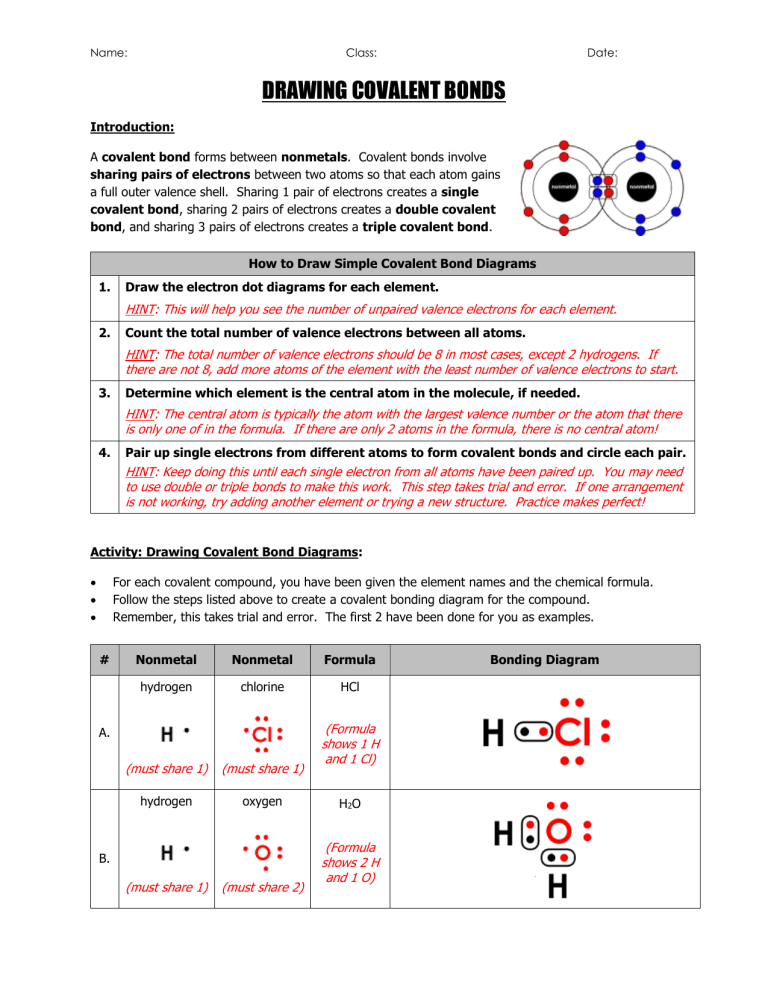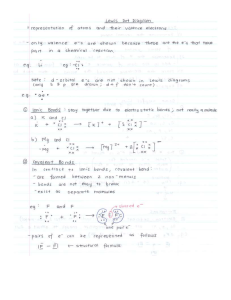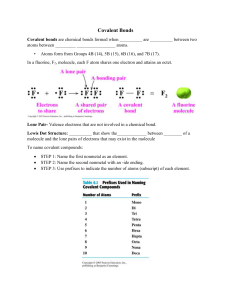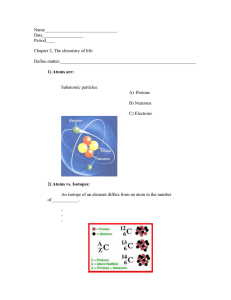
Name: Class: Date: DRAWING COVALENT BONDS Introduction: A covalent bond forms between nonmetals. Covalent bonds involve sharing pairs of electrons between two atoms so that each atom gains a full outer valence shell. Sharing 1 pair of electrons creates a single covalent bond, sharing 2 pairs of electrons creates a double covalent bond, and sharing 3 pairs of electrons creates a triple covalent bond. How to Draw Simple Covalent Bond Diagrams 1. Draw the electron dot diagrams for each element. HINT: This will help you see the number of unpaired valence electrons for each element. 2. Count the total number of valence electrons between all atoms. HINT: The total number of valence electrons should be 8 in most cases, except 2 hydrogens. If there are not 8, add more atoms of the element with the least number of valence electrons to start. 3. Determine which element is the central atom in the molecule, if needed. HINT: The central atom is typically the atom with the largest valence number or the atom that there is only one of in the formula. If there are only 2 atoms in the formula, there is no central atom! 4. Pair up single electrons from different atoms to form covalent bonds and circle each pair. HINT: Keep doing this until each single electron from all atoms have been paired up. You may need to use double or triple bonds to make this work. This step takes trial and error. If one arrangement is not working, try adding another element or trying a new structure. Practice makes perfect! Activity: Drawing Covalent Bond Diagrams: For each covalent compound, you have been given the element names and the chemical formula. Follow the steps listed above to create a covalent bonding diagram for the compound. Remember, this takes trial and error. The first 2 have been done for you as examples. # Nonmetal Nonmetal Formula hydrogen chlorine HCl A. (must share 1) (must share 1) hydrogen oxygen B. (must share 1) (must share 2) (Formula shows 1 H and 1 Cl) H2O (Formula shows 2 H and 1 O) Bonding Diagram # Nonmetal Nonmetal 1. hydrogen fluorine Formula HF 2. nitrogen chlorine NCl3 3. oxygen oxygen O2 4. carbon hydrogen CH4 5. oxygen carbon CO2 6. nitrogen nitrogen N2 Bonding Diagram Name: Class: Date: DRAWING COVALENT BONDS (KEY) Introduction: A covalent bond forms between nonmetals. Covalent bonds involve sharing pairs of electrons between two atoms so that each atom gains a full outer valence shell. Sharing 1 pair of electrons creates a single covalent bond, sharing 2 pairs of electrons creates a double covalent bond, and sharing 3 pairs of electrons creates a triple covalent bond. How to Draw Simple Covalent Bond Diagrams 1. Draw the electron dot diagrams for each element. HINT: This will help you see the number of unpaired valence electrons for each element. 2. Count the total number of valence electrons between all atoms. HINT: The total number of valence electrons should be 8 in most cases, except 2 hydrogens. If there are not 8, add more atoms of the element with the least number of valence electrons to start. 3. Determine which element is the central atom in the molecule, if needed. HINT: The central atom is typically the atom with the largest valence number or the atom that there is only one of in the formula. If there are only 2 atoms in the formula, there is no central atom! 4. Pair up single electrons from different atoms to form covalent bonds and circle each pair. HINT: Keep doing this until each single electron from all atoms have been paired up. You may need to use double or triple bonds to make this work. This step takes trial and error. If one arrangement is not working, try adding another element or trying a new structure. Practice makes perfect! Activity: Drawing Covalent Bond Diagrams: For each covalent compound, you have been given the element names and the chemical formula. Follow the steps listed above to create a covalent bonding diagram for the compound. Remember, this takes trial and error. The first 2 have been done for you as examples. # Nonmetal Nonmetal Formula hydrogen chlorine HCl A. (must share 1) (must share 1) hydrogen oxygen B. (must share 1) (must share 2) (Formula shows 1 H and 1 Cl) H2O (Formula shows 2 H and 1 O) Bonding Diagram # Nonmetal Nonmetal 1. hydrogen fluorine Formula HF 2. nitrogen chlorine NCl3 3. oxygen oxygen O2 4. carbon hydrogen CH4 5. oxygen carbon CO2 6. nitrogen nitrogen N2 Bonding Diagram




